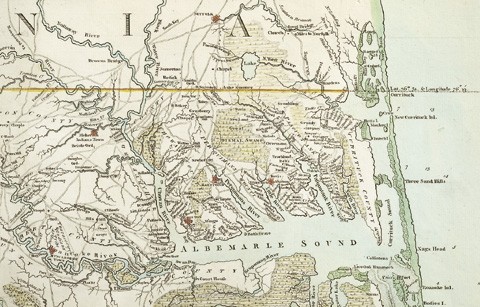
Detail of a map of North Carolina. (Courtesy, Colonial Williamsburg Foundation.) The approximate locations of (a) Thomas White in Northampton County and (b) John Sanders in Perquimans County, North Carolina, are denoted.

Desk attributed to Thomas White, Perquimans County, North Carolina, 1756–1766. Walnut with tulip poplar and yellow pine, H. 41 1/2", W. 40 1/2", D. 21." (Private collection; photo, Museum of Early Southern Decorative Arts.)
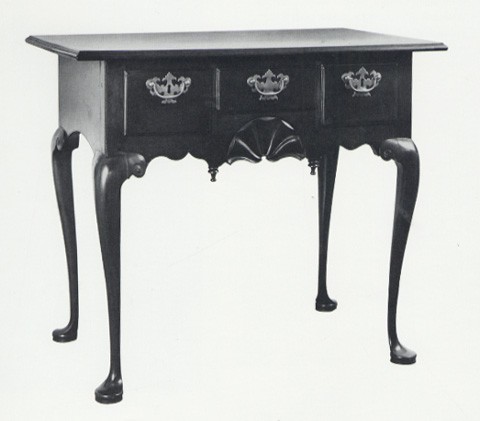
Dressing table attributed to Thomas White, Perquimans County, North Carolina, 1756–1766. Walnut with red cedar, yellow pine, cypress, and tulip poplar, H. 28 5/16", W. 34", D. 21 5/8". (Private collection; photo, Museum of Early Southern Decorative Arts.)
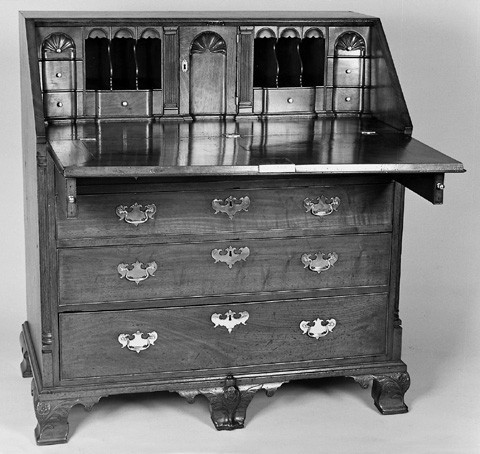
Desk attributed to Thomas White, Perquimans County, North Carolina, ca. 1765. Walnut with white cedar, yellow pine, walnut, and mahogany, H. 43", W. 39 1/2", D. 21". (Courtesy, Museum of Early Southern Decorative Arts.)

Cupboard attributed to Thomas White, Northampton County, North Carolina, ca. 1766. Walnut with yellow pine and tulip poplar. W. 43 3/4", height and depth not recorded. (Courtesy, Willow Oaks Country Club, Richmond, Virginia; photo, Museum of Early Southern Decorative Arts.)

Detail of the center foot on the cupboard illustrated in fig. 5.
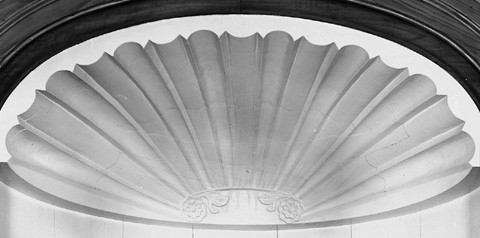
Detail of the laminated and carved shell in the cupboard illustrated in fig. 5.

Detail of the interior of the desk illustrated in fig. 4.
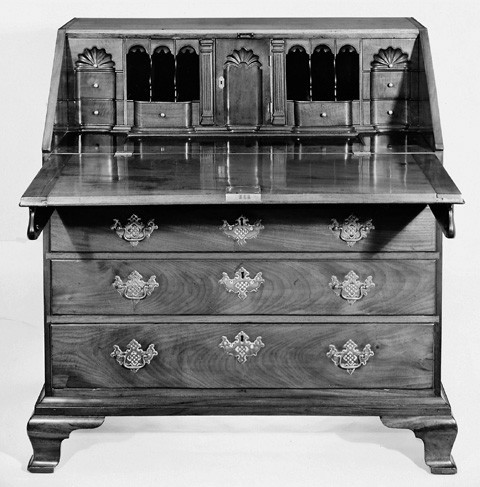
Desk with incised inscription “John Goddard 1754,” Newport, Rhode Island. Mahogany; secondary woods not recorded. H. 41 1/2", W. 40 1/2", D. 22 1/2". (Courtesy of Sack Heritage Group) www.sackheritagegroup.com

Detail of the interior of the desk illustrated in fig. 9
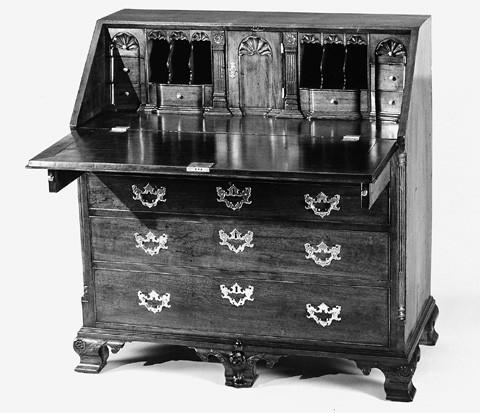
Desk attributed to Thomas White, Perquimans County, North Carolina, 1756–1766. Walnut with white cedar, yellow pine, and walnut. H. 43 1/4", W. 43 1/2", D. 21 5/8". (Private collection; photo, Museum of Early Southern Decorative Arts.) The base molding, feet, and brasses are replaced.
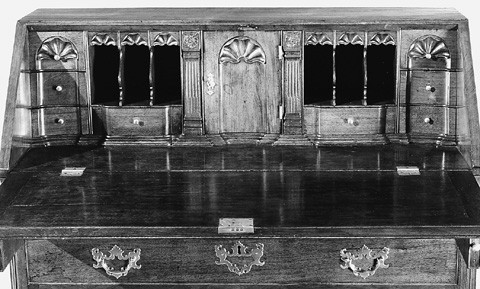
Detail of the interior of the desk illustrated in fig. 11.
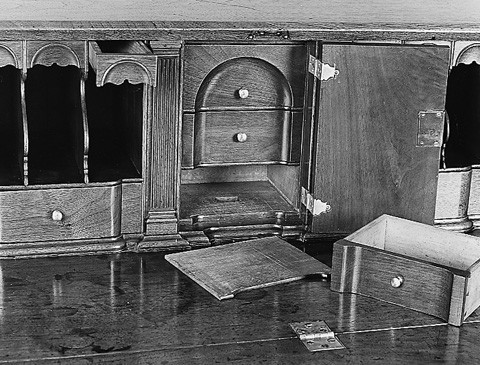
Detail of the false bottom in the prospect cabinet of the desk illustrated in fig. 4.
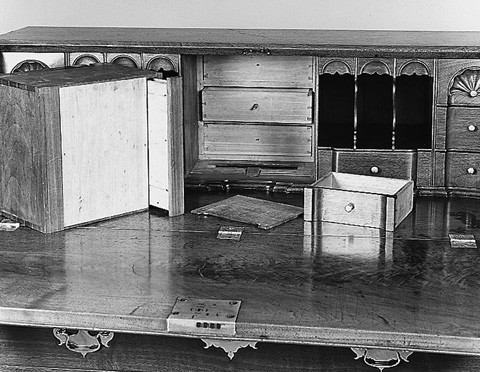
Detail of the prospect case removed from the interior of the desk illustrated in fig. 4.
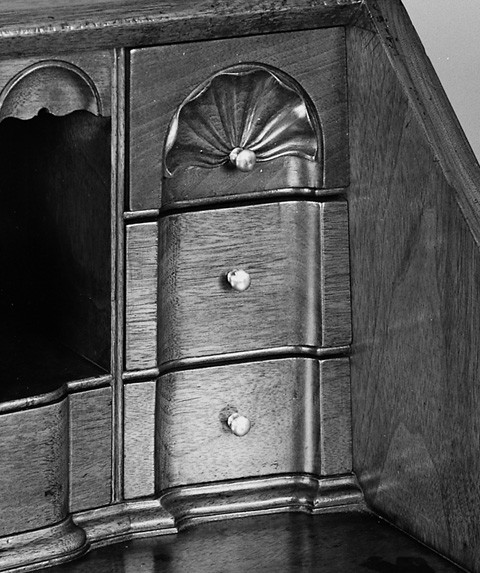
Detail of the flared interior drawers of the desk illustrated in fig. 4.

Detail of the drawers and a quarter-column on the desk illustrated in fig. 11.

Detail of a quarter-column base on the desk illustrated in fig. 4.
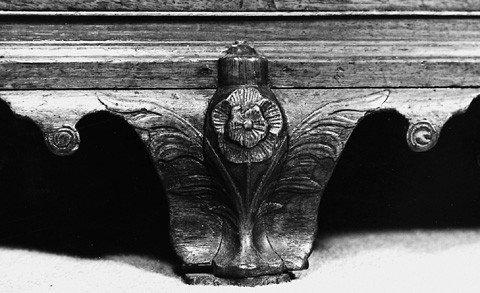
Detail of the center foot of the desk illustrated in fig. 4.
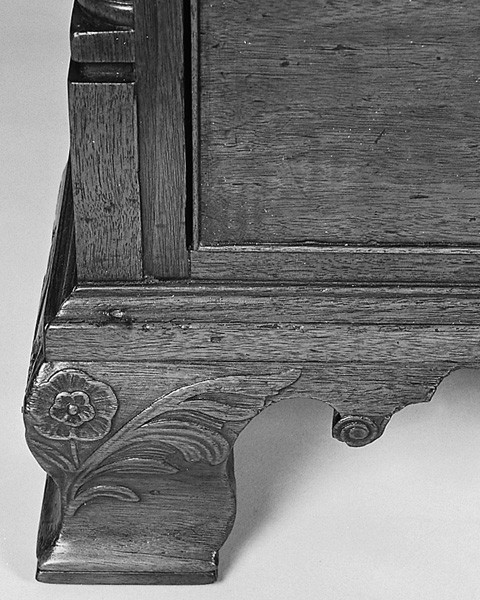
Detail of the left foot of the desk illustrated in fig. 4.

Detail of the shaped foot blocking of the desk illustrated in fig. 4.
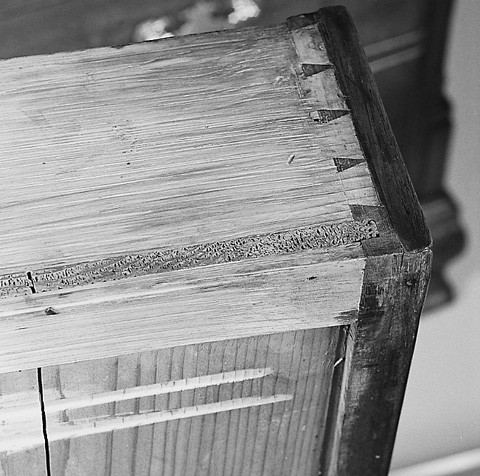
Detail showing the drawer construction of the desk illustrated in fig. 4.
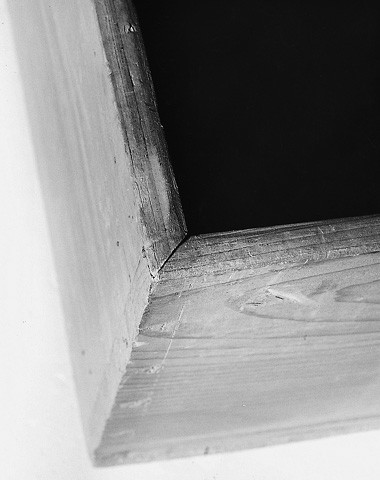
Detail of a mitered joint on the upper rear drawer frame of the desk illustrated in fig. 4.
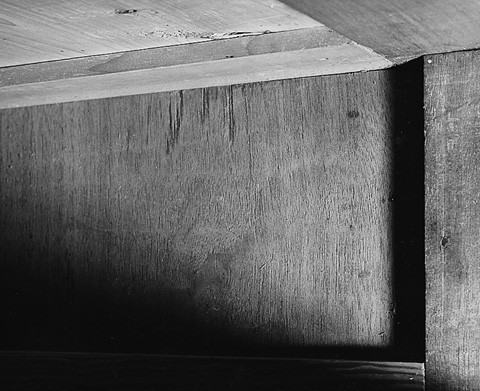
Detail of a half-bottom dustboard with kicker in the desk illustrated in fig. 4.

Detail of an upper leg and knee respond on the table illustrated in fig. 3, showing the curved upper profile of the knee at the leg stile.

Dressing table attributed to Thomas White, Perquimans County, North Carolina, 1756–1766. Mahogany with white cedar and yellow pine. H. 28 1/2", W. 32 1/2", D. 21 1/2". (Courtesy, Museum of Fine Arts, Houston; Bayou Bend Collection, museum purchase with funds provided by the Theta Charity Antique Show and Miss Ima Hogg, by exchange.)

Detail of the left front leg of the dressing table illustrated in fig. 25.
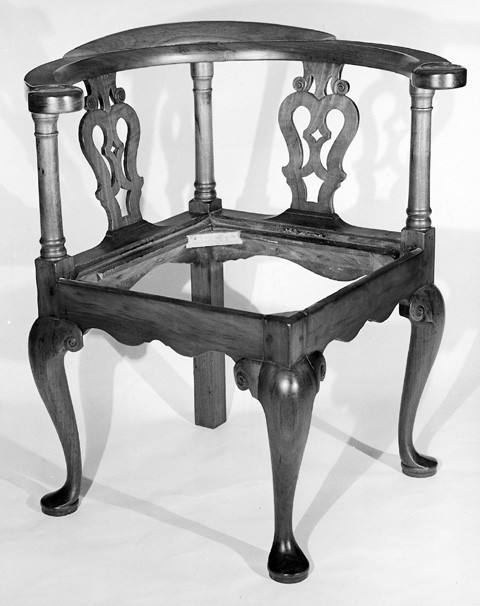
Corner chair attributed to Thomas White, Perquimans County, North Carolina, 1756–66. Walnut with yellow pine. H. 30 1/8", W. 18". (Courtesy, Museum of Early Southern Decorative Arts.)
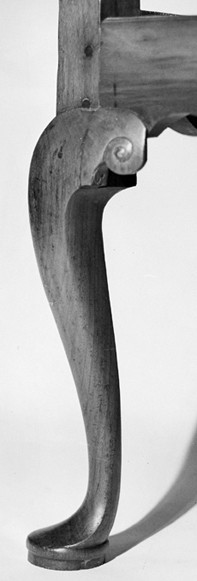
Detail of a leg on the corner chair illustrated in fig. 27.
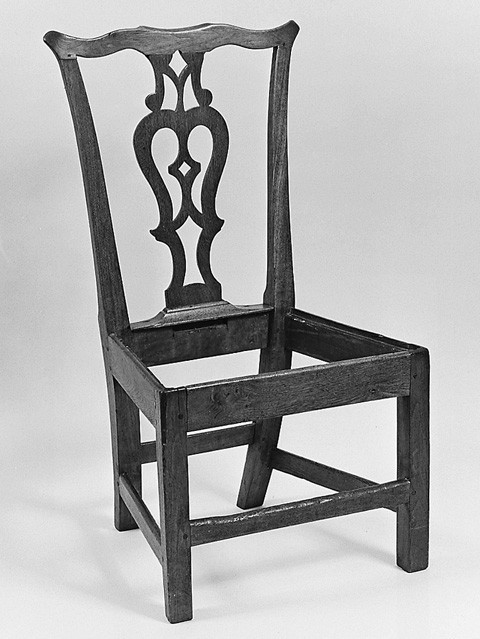
Side chair attributed to Thomas White, Perquimans County, North Carolina, 1756–1766. Walnut with yellow pine. H. 36 1/8", W. 19". (Courtesy, Museum of Early Southern Decorative Arts.) This chair has a history of descent in the Pettigrew family of Perquimans and Chowan Counties.
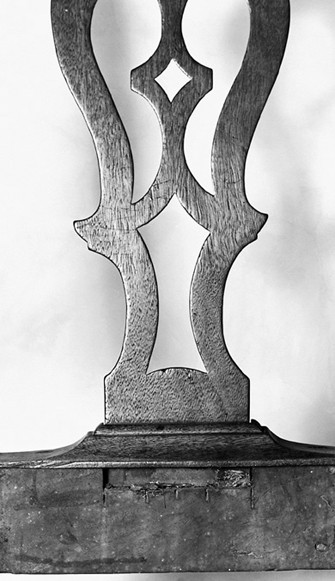
Detail of the open splat mortise in the rear rail of the side chair illustrated in fig. 29.
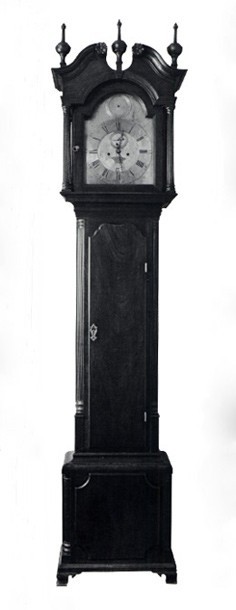
Tall case clock attributed to Thomas White, Northampton County, North Carolina, 1766–1788. Walnut with yellow pine. Dimensions not recorded. (Private collection; photo, Museum of Early Southern Decorative Arts.)

Detail of a quarter-column base on the tall case clock illustrated in fig. 31.

Desk attributed to John Sanders, Perquimans County, North Carolina, 1750–1760. Cherry with white cedar, cypress, and yellow pine. H. 42 1/8", W. 41 1/4", D. 21 3/4". (Private collection; photo, John Bivins.)

Detail of the interior of the desk illustrated in fig. 33.
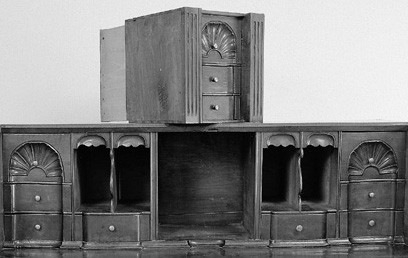
Detail of the prospect cabinet of the desk illustrated in fig. 33.
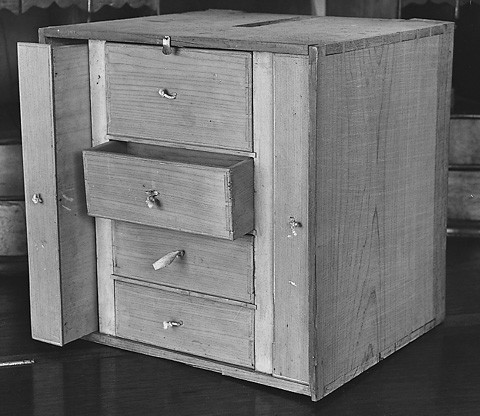
Detail of the prospect cabinet removed from a desk (not illustrated) attributed to John Sanders.
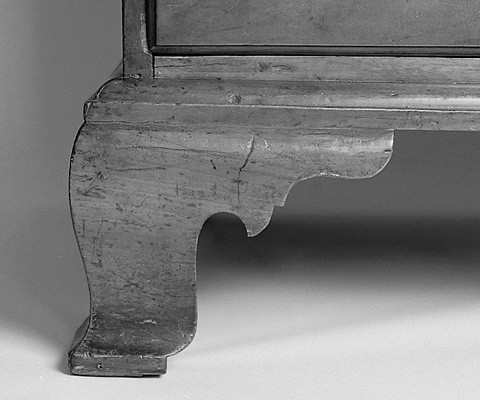
Detail of a foot on the desk illustrated in fig. 33.
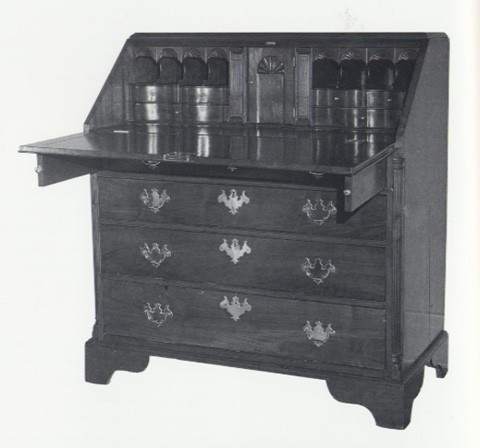
Desk attributed to John Sanders, Perquimans County, North Carolina, 1760–1776. Walnut with yellow pine, tulip poplar, and walnut. H. 42 1/2", W. 41 1/4", D. 21 7/8". (Private collection; photo, Museum of Early Southern Decorative Arts.)
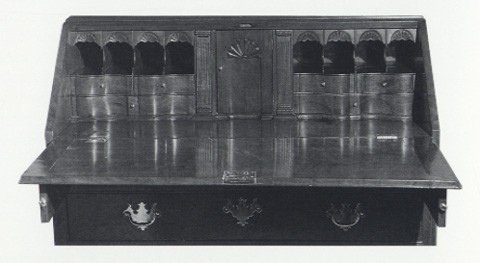
Detail of the interior of the desk illustrated in fig. 38.
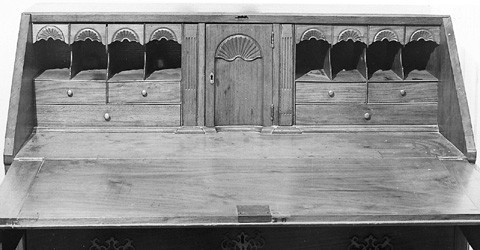
Detail of the interior of a desk (not illustrated) attributed to John Sanders, Perquimans County, North Carolina, 1760–1776. (Private collection; photo, Museum of Early Southern Decorative Arts.) The bases and capitals of the stop-fluted pilaster drawers are missing.
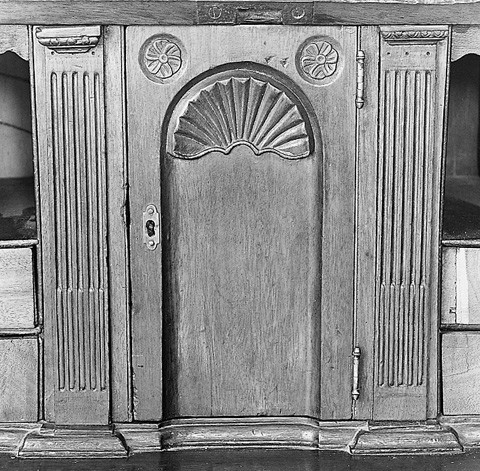
Detail of the prospect of a desk (not illustrated) attributed to John Sanders, Perquimans County, North Carolina, 1760–1776. (Private collection; photo, Museum of Early Southern Decorative Arts.) The feet of this desk are missing.

Detail of a quarter-column of the desk partially illustrated in fig. 40.

Tall clock case, Perquimans County, North Carolina, 1770–1790. Mahogany with white cedar and yellow pine. Dimensions not recorded. (Private collection; photo, Gavin Ashworth.) This clock descended in the Moore family of Perquimans County, North Carolina.
During the seventeenth century, commerce with urban New England was common in the lower Chesapeake Bay region. The latter area, which comprised portions of southeastern Virginia and northeastern North Carolina, was defined not only by the geography of the bay but also by local styles in material culture, particularly domestic architecture and furniture. Despite the presence of joiners in this area of the South, early inventories from both colonies commonly list items such as “Boston chairs” among other household movables. In 1729, William Byrd wrote a Scottish merchant that “trade . . . is engrosst by the Saints of New England,” who shipped out quantities of Carolina tobacco “without troubling themselves with paying that Impertinent Duty of a Penny a Pound.”[1]
Although commerce with the middle colonies was well established by the second quarter of the eighteenth century, merchants, artisans, and ship captains from the Massachusetts Bay area dominated the Atlantic coastal trade throughout much of the colonial period. Boston led in the export of manufactured goods such as chairs and case forms, but other New England ports shipped significant quantities of furniture to the Chesapeake Bay region. During the second and third quarters of the eighteenth century, Newport and Providence were second only to Boston in exporting furniture to the South.[2]
Quaker communities were an important factor linking settlements along the Atlantic coast. During the seventeenth century, persecution contributed to the cohesive nature of Quaker communities in Virginia, just as it had in Massachusetts and Rhode Island. In 1660, Virginia passed an act for “suppressing Quakers,” who were considered an “unreasonable and turbulent sort of people,” particularly by sour and frustrated Anglican priests who usually found their own Sunday meetings unoccupied. This attitude was also found in North Carolina, where the established church had little effective structure much before the middle of the eighteenth century.[3]
One cause of the protracted ecclesiastical dichotomy between Anglicans and Quakers in North Carolina was the entrenched political power of the Friends during the Proprietary period of government. After the 1720s, other Protestants in the colony began to realize that the strong ties among tidewater Quaker planters and merchants bolstered trade with the northern colonies. Of particular importance in this trade were Newport and Philadelphia. The former carried on a varied commerce with the South that included both staples and manufactured goods, particularly furniture.[4]
Philadelphia exported even larger quantities of manufactured wares during the colonial period, including woven goods and cast iron, but, with the exception of Windsor chairs, furniture was not a significant export to the South until after the Revolution. Colonial Philadelphia furniture with North Carolina provenances almost invariably documents importations resulting from private purchases. Several of these purchases were made by North Carolina Quakers who regularly traveled to Philadelphia on business and to attend Monthly and Yearly Meetings there.
The earliest American furniture–exporting cartels were typically formed by cabinetmakers rather than “shippers.” By the late eighteenth century these tradesmen regularly assembled large furniture inventories for consignment in the venture cargo trade. Ventures were profitable but risky. In 1750, John Lyon of Massachusetts, “Owner and Master of the Sloop . . . Mary,” and “Constant Bailey John Cahoone and Benjamin Peabody all of Newport . . . joyners” agreed to “proceed from Newport to North Carolina and from thence back.” The partners evidently had a factor or partner in North Carolina to oversee the sale of their cargo since no one had the responsibilities of a supercargo. A possible survival of this partnership’s venture is the top of a high chest of drawers, signed in ink “Maid by Constant Bailey Shop joyner in Newport Rhode Island.”[5]
New England venture cargo could be purchased at most of the viable ports and king’s landings dotting the bays, estuaries, and rivers of North Carolina’s ragged and dangerous coastline. The northeastern section of the colony, known as the Albemarle region, was settled earliest—mostly by British Virginians—and therefore prospered before the colony’s other maritime regions, the Pamlico and Cape Fear. Only a single inlet, Ocracoke, offered relatively constant but treacherous entry for smaller vessels, usually sloops such as Lyon’s Mary. After having crossed the dreaded Outer Banks, however, vessels of reasonable draft could reach most of the Albemarle Sound’s various landings. Of particular advantage to maritime trade were the long estuaries of the Pasquotank, Perquimans, and Chowan Rivers and the navigability of the Roanoke River far into the hinterland.
The strongholds of Quaker society in mid-eighteenth-century North Carolina lay on the large necks of land jutting into the Albemarle Sound between the Little River and the Pasquotank River in Pasquotank County and the sections of Perquimans County separated by the Perquimans River estuary (fig. 1). Although farmers and merchants in northeastern North Carolina were unable to export great quantities of staples due to the poor navigability of the waterways, the rich black estuarine loam of these counties provided some of the most productive farmland in the coastal plain. It also allowed the industrious Quaker planters of the region to garner a decent estate, at least until the post-Revolutionary period when slavery became an increasing factor in the management of large agrarian holdings. The late eighteenth century marked a very substantial out-migration by Quakers moving west and northwest from the Albemarle region. Much of this emigration was composed of planters who sought markets for grain and other profitable staples that could be raised without the use of slave labor.[6]
In the middle of the eighteenth century, only a glimmering of such troubles was evident along the northern reaches of the Albemarle Sound. For a rural setting, the region was densely settled. The tiny port of Nixonton, which became a center of Quaker commerce, was established on the Little River in Pasquotank County during the late 1740s. The town of Hertford, established at the head of the Perquimans River estuary in 1757, was also situated on and around land owned by prominent Quaker planters. Although both towns were central to regional commerce, neither had more than two hundred fifty inhabitants throughout the colonial period. As studies of densely populated rural areas have demonstrated, however, urban centers were not necessary for the bench trades to flourish. Where planters had successfully developed the land and amassed large holdings through intermarriage, artisans were bound to follow. This situation especially was true of the Albemarle region, where the importation of bulky, finished goods was difficult and expensive before the Revolution. Norfolk grew rich from trade with northeast North Carolina, while Carolinians steadily complained of the usury that befell them at the hands of the merchants and middlemen who controlled overland trade between the two colonies.
Thomas White and John Sanders
Overland trade between North Carolina and Virginia was encouraged not only by poor navigation but also by family and mercantile links during the seventeenth and early eighteenth centuries. Nowhere was this connection more evident than in the Quaker communities of the Albemarle, which were settled largely by Friends from Nansemond and Isle of Wight Counties in Virginia. Quaker cabinetmaker Thomas White was born in Isle of Wight County, where his family had been located since the seventeenth century. The Whites were members of the Western Branch Monthly Meeting in Nansemond County.[7]
Thomas White’s father, Joseph, was one of the successful Quaker planters of the Western Branch Society. Joseph began purchasing land in Perquimans County, North Carolina, as early as 1748, although he did not move his family from Virginia until 1750. Thomas arrived six years later, after receiving a certificate from the Isle of Wight Meeting to attend the Perquimans Monthly Meeting. Thomas White’s trade history between 1750 and 1756 remains an enigma, but there is little doubt that he worked in both Rhode Island and Virginia before moving to North Carolina. His blend of stylistic and structural traditions from all three colonies has enabled furniture historians to identify his work. This distinctive but highly contained style was shared by at least one other eastern North Carolina cabinetmaker, John Sanders.[8]
Because Rhode Island’s stylistic imprint is so strong in White’s work (fig. 2), some scholars assumed that the furniture attributed to him was simply copied from Newport or Providence pieces exported to the Albemarle. Although ample documentation for Rhode Island imports into the colonial South survives, White’s work habits and stylistic vocabulary are the result of his training and shop experiences rather than fashionable plagiarism. Despite the Quaker practice of recording the movement of members traveling between communities, documentation of White’s presence in Rhode Island remains elusive. Regretably, significant portions of the Western Branch records for this period are missing.
Although much is known about Quaker shopmasters such as the Townsends and Goddards, lesser mechanics in Newport and Providence are not always well represented in the colonial records. Unless they fell upon hard times, died, were reproached by elders of the church, or appeared before a local court, little is known of many journeymen. They could be propelled to instant community recognition by marriage, the acquisition of real property, or both. The records of apprentices in any colony were exceedingly scant unless they were orphans, which occasioned the official filing of indentures.
Thomas White probably had a standard apprenticeship contract with his master; however, there was no legal requirement for filing private indentures with the court, and the British carried off most of Newport’s apprenticeship records in 1779. Furniture historian Matthew Hobbs recently discovered that a Thomas White witnessed the marriage of James Goddard and Susanna Townsend in Newport in January 1750/51. Susanna was the daughter of Newport cabinetmaker Job Townsend, and James was the brother of Job’s former apprentice and son-in-law, John Goddard. White also signed another marriage certificate in Newport in early 1753.[9]
Commercial and family ties with Rhode Island were common in eastern North Carolina Quaker communities. Joseph Skinner, who lived near the Whites in Perquimans County, traveled to Newport in 1768 and remained there for at least seven months. A “Book of Discipline” that descended in his family contains the phrase “Transcribed and Examined by Joseph Skinner at Newport on Rhod Island” on the cover page, as well as notations regarding the births of William White’s children. William was one of Thomas’s brothers.[10]
If White did not serve his apprenticeship in Newport, he must have trained with a Rhode Island cabinetmaker who had immigrated to the South. Other than the furniture attributed to John Sanders, however, no other North Carolina or Virginia work has such strong Rhode Island attributes. Not only is Sanders’s work less sophisticated than White’s in its adaptation of Rhode Island features, but aspects of White’s style suggests that he left Rhode Island before 1760, when some classical Newport details were still formative.
White returned to Isle of Wight County, Virginia, before following his family to North Carolina in 1756. Three years later, Joseph White left his “son Thomas . . . two Lotts in the Town of Hertford and all the Joyners tolls belonging to his trade.” How long he sojourned in Virginia before making this move is uncertain, but several aspects of his work have parallels in Virginia furniture. On June 6, 1756, the Virginia Gazette carried an advertisement for a riding chair that was placed by “Mr. White,” a cabinetmaker in Williamsburg. This notice appeared about three months after White ostensibly moved to North Carolina.[11]
In terms of patronage, White’s move from Virginia to North Carolina was advantageous. His family had settled on Castleton’s Creek (now Raccoon Creek) in Perquimans County—home to some of the wealthiest Quakers in the region. The dressing table illustrated in figure 3 has a history of ownership by Martha Anne Blount, who married Joseph Skinner in 1780. Considering the date range of this piece, it more likely descended in the Skinner family. Joseph and his brother Joshua were both prominent members of the Perquimans Quaker community.[12]
Joshua and Martha’s daughter Elizabeth married Quaker Exum Newby, Jr., who had inherited a house and plantation called “Belvidere” from his father. The house, which is located on the Perquimans River about eight miles from the Skinners’ land, may have been built by Exum’s grandfather, Thomas. The elder Newby was a merchant who sold a broad range of general merchandise and exported local staples such as tar, pitch, turpentine, masts, spars, and planking. During the early 1760s, he owned half-shares of the schooner Two Brothers and the sloop Salley, as well as interests in other vessels. Thomas also appears to have been the original owner of the desk shown in figure 4.[13]
Thomas Newby’s account books reveal that White owed him £20.10.2 in 1765. In October and November of that year, White paid his debt in cash and furniture, including a desk valued at £12 and a table valued at £2.10. The desk (fig. 4) evidently passed from Thomas to his son Exum, Sr., and then to Exum, Jr. White continued to provide Newby with furnishings the following year. In January 1767, after White had departed the county, Newby owed the cabinetmaker £15.15.0 for “12 Leather Chairs” valued at 25s 8d each and “1 small ovel table” valued at £1.15.[14]
Because of the aforementioned provenances and White’s documented movement in North Carolina, the furniture attributed to him can be assigned relatively tight date ranges. The work he completed in Perquimans County dates from 1756 to 1766. In the latter year, he moved to Northampton County, about forty miles west of Perquimans, and married Pharaby Duke, daughter of Northampton County planter and sheriff John Duke. White and his wife lived in a brick-ended, gambrel-roofed house that John Duke evidently built for the newlyweds about the time of their marriage. After research verified White’s second location in North Carolina, a carved “bowfat” (figs. 5-7) installed in his house became a keystone for attributing other pieces to his shop. White made the bowfat as a freestanding unit, but he inserted it into a niche incorporated in the paneling. The square lights at the bottom of the upper doors probably had raised panels rather than glass, a feature common on cupboards made in the Albemarle region.[15]
The furniture associated with White’s Northampton County period differs little from his earlier Perquimans County work. Although White prospered in Northampton County and worked at the cabinet trade until his death in 1788, his estate inventory indicates that farming provided his principal income. His livestock, crops, and agricultural tools had at least twelve times the value of his shop, tools, materials, and stock. If White’s twenty-six slaves are included, the value of his farming enterprise was over a hundred times that of his cabinet business. Like many artisans who settled in the rural South, White’s bench trade provided him with the path and means to reach his own social ideal: not so much recognition as a superior mechanic but the status accorded a wealthy planter. Whether frugality or love of the cabinet trade compelled him to operate his shop until the time of his death is unknown, but he certainly had no need to do so.[16]
Another Quaker cabinetmaker influenced by Rhode Island and Boston styles was John Sanders, a neighbor of White’s in Perquimans County. Five desks have been attributed to Sanders based upon his family affiliations, extensive shop inventory, and proximity to White. Although Sanders may have been born in Perquimans County, he does not appear in local records until 1751, when he inherited various cooper’s tools from his uncle, Abraham Sanders. John married Elizabeth Symons of Pasquotank Monthly Meeting in 1757. Two years later, Thomas Newby described him as a “joiner” when Sanders purchased yard goods and tools. Sanders also referred to himself as a joiner in the preamble to his will, but his estate inventory reveals that he was primarily a cabinetmaker and planter.[17]
At the time of his death in 1777, Sanders owned eleven slaves, seven of whom were male. His inventory indicates that his shop was the largest in Perquimans County and one of the largest in the Albemarle region. Sanders’s livestock and agricultural holdings were similar to those of Thomas White, making him a successful “middling” planter. Witnesses to his will were William Skinner, Thomas White’s brother John, and cabinetmaker Josiah Murdaugh. Sanders’s executors included his brother Benjamin, Joshua Skinner, White’s brother William, and Charles Moore, who was probably a Perquimans County cabinetmaker.[18]
Although Thomas White was not working at the cabinet trade in Virginia before the mid-1750s and did not move to Perquimans until 1756, John Sanders could have been working in the county as early as the late 1740s. With the exception of shared stylistic details, there is no evidence that Sanders and White were associated in the trade, nor do we have any inkling of how Sanders became exposed to the New England styles evident in the furniture that is now attributed to his shop.
White died on December 25, 1788. His inventory was taken the following March, and his personal effects were sold in June. Although the furniture attributed to him suggests that he was an accomplished and prolific workman, the contents of his shop were typical of an artisan working by himself or, in this instance, perhaps with one other tradesman. White’s inventory listed one workbench, which does not appear in the record of his estate sale. He may have left the bench to his son and probable apprentice, John Duke White. John purchased more items than any other individual at his father’s estate sale, although other cabinetmakers such as Thomas and George Sharrock and William Grant were present. Among the younger White’s acquisitions were bench planes, a “Glew pott,” and a “sett [of] turning tools & bench [lathe].” Surprisingly, George Sharrock purchased all of the “Joiners pattents” for 5s. Described as “a parcel [of] Joiners patterns” in Thomas White’s inventory, these templates were most likely for chair parts. “Black walnut” constituted the largest percentage of White’s timber, but he also stocked other woods including “Juniper,” or Atlantic white cedar. The latter wood appears in much of the furniture attributed to White.[19]
Sanders’s shop was much larger than Thomas White’s and included “6 Work Benches” and tools sufficient for several journeymen and apprentices. His woodshed contained over forty-two parcels of timber—including pine, cherry, gum, walnut, poplar, oak, ash, “juniper,” and mahogany—totaling more than 9,000 board feet. Unlike White, Sanders had a broad range of fasteners and furniture hardware such as “Bofat furniture,” “Desk and Bookcase furniture,” and a variety of hinges and locks. The shop also contained sizable quantities of glue, paint pigments, beeswax, leather, and “Wove Wire,” an expensive item that sold for £3.12.6. Unfortunately, the names of purchasers at Sanders’s sale were not listed. Excluding property and slaves left to his family, Sanders’s personal effects brought a total of £866.8.9. Of this amount, materials, supplies, tools, and furniture components in the shop brought over £200. Allowing for the rampant inflation of the time, the shop effects may have been worth as much as £100 sterling.[20]
Despite the large size of his cabinet shop, Sanders manufactured agricultural implements and provided services comparable to those of smaller regional cabinetmakers. His inventory lists a “parcel of fan timber,” which was intended for wheat fans for winnowing grain, “Clock Real timber,” and “Winsor Chair & Wheal timber”—the earliest reference to Windsor furniture production in North Carolina. The “Wheal timber” may have consisted of hubs, spokes, or felloes for linen or vehicle wheels. In coastal North Carolina, makers of riding chairs often produced Windsor furniture as well. The seats of these rakish, two-wheeled conveyances usually consisted of a Windsor chair or short bench. Sanders owned a lathe and tools necessary for making Windsor furniture; however, very few cabinetmakers ventured into the specialized business of making “stick” furniture. Conversely, few Windsor chairmakers engaged in the manufacture of case furniture.[21]
The Furniture of Thomas White
The furniture that Thomas White made in North Carolina provides the strongest evidence of his presence in Rhode Island. New England styles influenced furniture production in several areas of the coastal South, largely owing to the immigration of northern artisans. Boston cabinetmaker Jonathan Badger, for example, arrived in Charleston in 1747 and worked there until the early 1770s. A small group of coastal South Carolina chairs and case pieces with Massachusetts stylistic and structural details may be from his shop. Similarly, a desk attributed to Norfolk, Virginia (at Colonial Williamsburg), has a Boston-style blocked facade; however, its overtly architectural interior, feet, and secondary woods are characteristic of southeast Virginia work.[22]
The interiors of two desks attributed to White (figs. 2, 8) show how Newport and Providence designs influenced regional styles far away from Rhode Island. Not surprisingly, similar features are found on desks from the coastal and inland counties of Connecticut. Both the plan and elevation of many Rhode Island and Connecticut desk interiors have precedents in Boston furniture. The stylistic exchange between the “metropolis” of New England, as Boston was known, and Rhode Island and Connecticut has long been evident, although it has received scant mention in scholarly publications.
The interior of the desk illustrated in figure 4, which features a central prospect flanked by blocked drawers surmounted by pigeonholes and an outer tier of three drawers (fig. 8), has parallels in both Rhode Island and Massachusetts designs. A basic departure from the standard Rhode Island format, however, is the inclusion of fluted pilasters on either side of the prospect. A Newport desk with the incised inscription “John Goddard 1754” (fig. 9) is unusual in having essentially the same interior as the Newby desk (figs. 8, 10). All the desks attributed to White (figs. 2, 4, 11) have pilasters that are integral with the prospect cabinet (see figs. 8, 12), a detail rarely encountered outside the Albemarle region. The cabinets are removable and conceal a number of secret drawers (figs. 13, 14).[23]
The interior drawers of the desk illustrated in figure 2 have more in common with Massachusetts examples than with those from the Narragansett region. The same is true of the outermost interior drawers on the other desks attributed to White (figs. 2, 4, 11). The fronts splay outward at the case sides, increasing in width as they approach the writing surface (fig. 15). This baroque feature occurs frequently on desks from Boston and the New London County area of Connecticut.[24]
The concave prospect shell of the desk shown in figure 4 is similar to Newport examples, but its radiating lobes are outlined with parting-tool cuts rather than being sanded smooth (fig. 8). The use of a V-shaped parting tool in this context may be a “signature” of White’s work. The carving on the other White desks (figs. 2, 11, 12) is more conventional, but all of the shells and valence designs are set within plain arches. Rhode Island desk interiors usually have shells with scalloped edges bordered by incised lines; however, shells set within plain arches are common on the front rails of Newport dressing tables and high chests. All of the shells attributed to White have shaped bottom edges. In Rhode Island desk interiors, such shaping is usually confined to prospect shells; the shells on flanking drawers are typically straight at the bottom (see fig. 10).
The tiny C-scrolls at the bottom of the prospect shells on White’s desks are open (figs. 2, 8, 11) rather than having incised or hollowed lobate designs like those on some later Newport examples. The former treatment appears to be typical of Newport work dating from the 1740s and 1750s. This is consistent with White’s chronology, as are other details of his work that follow formative, midcentury aspects of Rhode Island style. The valences of the Newby desk conceal drawers (fig. 8), but neither their edge shape nor the depth of their hollows are as sharp and consistent as Rhode Island examples (see fig. 10). The latter are so precise that they appear to have been cut with a jig—possibly a double-edged, scratch-stock cutter mounted on an arbor. The profiles of the pigeonhole partitions, however, are based on a common Newport pattern.
Other aspects of White’s work diverge more sharply from Rhode Island norms. The fallboards on desks attributed to his shop (see fig. 4) have mitered battens, or “clamps,” whereas those on most examples made north of the southernmost counties of Connecticut are straight. Straight battens are not as elegant as mitered ones, but they are less likely to cause the fallboard to crack if it shrinks and expands seasonally. The cockbeading on White’s desks is attached to the drawer fronts (fig. 16). On most Rhode Island and Massachusetts case pieces, the cockbeading is planed on the drawer dividers and rabbeted and nailed to the case sides. White’s application of cockbeading is the most common method encountered on southern case pieces.[25]
All of the desks attributed to White have quarter-columns, which are rare on Rhode Island examples. On the desk shown in figure 11, the columns are stop-fluted (fig. 16) like those on the upper sections, waists, and pillars of some Rhode Island desk-and-bookcases, tall clock cases, and stands. White’s columns rise from very tall plinths with applied thumbnail moldings (fig. 17). The moldings are glued into dadoes below the column bases, just as they are on the plinths of some Newport tall clock cases and chests of drawers. The moldings on the desks illustrated in figures 2 and 4 are missing, but they were undoubtedly similar to those on a tall clock case attributed to White (figs. 31, 32). Tall quarter-column plinths with thumbnail moldings are common on British case furniture, particularly on chests of drawers.[26]
The base moldings used by White have bold fillets, but the ogee elements above are relatively restrained (see figs. 2, 4). By contrast, Rhode Island base moldings have a dramatic quality reminiscent of architectural surbases (see fig. 9). Most case pieces from the lower Chesapeake region have relatively simple base moldings.
The feet on White’s desks deviate significantly from New England examples, both in design and number (see figs. 2, 4). Center feet do not appear in any Anglo-American tradition from the northern colonies, although they occur sporadically in furniture from the middle Atlantic region and the South. One might speculate that the impetus for center feet in White’s work was the often large and elaborate base pendants of Boston, Charles Town, and Salem furniture, but it is more likely that White was following another British tradition. A large, claw-and-ball-foot secretary-press attributed to Williamsburg cabinetmaker Peter Scott (fl. ca. 1721–d. 1775) has a center foot, albeit to help support the weight of its wide case and contents. Center feet also occur on furniture from North Carolina’s Roanoke River basin, where White later moved. Although he probably influenced local styles to some degree, it is equally possible that the center feet on many Roanoke River basin pieces have antecedents in other British traditions. White’s center feet have a distinctive protruding element in the middle (figs. 2, 6, 18). Although they appear to be turnings, these elements are cut from a square billet and mitered into the foot facings and base molding. After fitting the joints, White completed the shaping process.[27]
The flower and leaf designs on the feet of the Newby desk (figs. 18, 19) have a certain affinity with the rigidly symmetrical carving on Newport cabriole legs; however, White’s sharp fronds are not as crisply executed as those in most Newport work. The simple flowers carved by White (see figs. 2, 6, 18) are somewhat more naturalistic than his quickly veined and soft-edged leaves. White’s finish work also distinguishes his carving from that of his Newport contemporaries. Whereas Newport carvers often used sandpaper, particularly on broad concave and convex surfaces, White finished much of his work with chisels and gouges alone.
Classic Newport feet have two very distinctive features that are not present on White’s work. The most prominent of these is the profile, which on Rhode Island foot facings calls for a rather straight inside silhouette that does not mirror the more accentuated, bench-planed curve formed at the foot miters (see fig. 9). Rather than using this charmingly unique Rhode Island nuance, White followed the practice standard for most American ogee feet wherein the inner and outer curves match (see fig. 19). The outer profile of an ogee foot is produced by cutting the miter on a hollowed board and not by sawing it to a standing pattern like the inner profile. After hollowing the board with a series of flat and convex-ironed planes, most workmen probably finished their feet with a scraper cut to the shape of the foot facing. On White’s feet, this surface matched the profile of the standing pattern used for scribing off the major curves of the inner profile of the feet.
The upper inside profiles of White’s feet, which have an ovoid volute surmounted by a fillet and a cyma (see figs. 18, 19), are close to those on Boston and Providence case furniture. White used the same foot on the cupboard illustrated in figures 5 and 6, even though he intended to install the piece in a niche with a full architrave. The second Rhode Island foot detail omitted by White is the rear profile of the back foot facings, which in Newport and Providence are often sawn to match the planed hollows and curves of the faces. White’s rear feet have angled back supports like those on most ogee feet made outside Rhode Island.
Although one might assume that White copied his desk interiors from Newport examples shipped south in the venture cargo trade, many of his construction techniques derive from Rhode Island cabinetmaking traditions. Stylistic plagiarism was common in the eighteenth century, but few artisans would bother to copy the structure of other tradesmen or mimic their work habits. The feet on White’s desks, for example, have sculpted vertical and horizontal blocks (fig. 20), much in the Rhode Island manner.
The large drawers on case pieces attributed to White’s shop are also constructed like many early Rhode Island examples. The drawer bottoms are dadoed to the front, glued and nailed to the sides and back, and fitted with glue strips (fig. 21). To prevent the drawers from sliding too far into the case, White attached stops to each drawer rail (the space provided by the glue strips under the bottoms allows the drawers to move back and forth over the stops on the drawer dividers). Although his drawer construction may appear somewhat generic from a New England perspective, most lower Chesapeake case pieces made after the 1740s have flat drawer bottoms that are dadoed to the front and rabbeted to the sides. The rabbets are generally deep enough to accommodate the bottom and glue strips attached to front and sides.
Even White’s finishing marks—scrawled chalk letters that indicated “tried” (trued) surfaces—are very elaborate, like those on the inner drawer surfaces of Rhode Island and eastern Connecticut furniture. A mark frequently used by him resembles the conjoined script initials “JC.” The drawer frames with such marks, however, share a feature unknown in Newport or Providence construction. The upper rear corners of the frames are mitered (fig. 22), a finish detail that White probably learned in Virginia.[28]
The large drawers of White’s case pieces run on three-quarter or full-depth dustboards, or “partitions” as they were called in the eighteenth-century cabinet trade (fig. 23). The dustboards, which occupy only half of the dadoes, have spacer strips attached on either side. These spacers also function as “kicks,” which prevent the drawer below from tilting down. Some Boston case pieces from the 1730s and early 1740s have full-depth dustboards, which typically occupy either half or all the height of the dado. With the exception of a few Portsmouth pieces in the Boston style, most of the case furniture from other New England centers has nailed drawer supports rather than dustboards. The latter are much more common on furniture from the middle colonies and the South.
Two dressing tables attributed to White (figs. 3, 25) have details that initially appear different from Rhode Island work; however, some of these features may reflect stylistic flux during the period when White’s vocabulary began to coalesce into his own distinctive adaptation and modification of Newport details. Most Newport dressing tables have a long drawer over two small drawers, whereas White’s have three small drawers. The latter arrangement may have been inspired by the lower drawer rank of Newport high chests, which typically feature a shallow center drawer flanked by two deeper drawers. At least two Newport dressing tables have the same drawer arrangement as the White examples, and both appear to pre-date 1760. As on the bases of high chests, the shells on Rhode Island dressing tables are usually positioned high on the cove-and-ovolo-shaped skirt. The shells on White’s dressing tables are set lower and their center C-scrolls are plain.[29]
The dressing table that descended in the Skinner family (fig. 3) has a more baroque aspect in retaining fillets for turned drops; however, both tables have scratch-beaded skirts—a vestigial detail related to the applied cockbeading on tables and high chest skirts from the late seventeenth and early eighteenth centuries. Although scratch-beading is rarely found on New England dressing tables with cabriole legs, it occurs in other areas of eastern North Carolina and in the Norfolk area of Virginia.[30]
The shape of the upper legs and knee responds on the White tables are also somewhat baroque in manner (figs. 24, 26). The knees are curved where they meet the leg stile, and their arcs are extended by responds glued to the faces of the front and side rails. By contrast, the knees on Newport high chests and dressing tables typically meet the leg stiles at right angles. The latter are usually glued and nailed to the lower edges of the rails, whereas curved responds had to be attached to the face of the frame. Knees similar to White’s occur on furniture from New England—particularly from Boston and areas it influenced—New York, and southeast Virginia. The bottom profiles of the knee responds on White’s tables have similar regional parallels, although carved volutes are atypical of Boston work. White’s responds are remarkably close to those on case furniture and chairs attributed to Peter Scott.[31]
White’s “round” feet are relatively broad (see figs. 3, 25, 27, 28). Like some Rhode Island examples, they have sharp nosings that return with a ring-like projection at the back. Most New England turned feet have either flattened or no nosing at the rear. Typically, the back of the foot or “hock” is shaved or filed away. Also like Rhode Island work, the disks under White’s feet are flared, but their diameter is larger, set in little more than 1/8" from the foot nosings.
One of the dressing tables attributed to White has knee carving composed of large C-scrolls, with simple radiating elements below them (figs. 25, 26). The design of the carving is rigidly geometric, more akin to work from southeastern Connecticut than Rhode Island. White’s deviation from mainstream Rhode Island designs, however, may represent little more than a lack of training. His twelve “Chizzels & Gouges” would not have been adequate for setting-in and modeling the more elaborate carving designs typical of Newport. Considering the apparent limitations imposed by his tool kit and training, White’s carving appears to reproduce in a fundamental and naive way the principal upper elements of the carving on a high chest attributed to John Townsend (now in the Museum of Fine Arts, Boston).[32]
The paneled trifid feet on the dressing table illustrated in figure 25 are one of the most surprising details used by White. In the coastal South, trifid feet occur only on furniture from the Rappahannock River basin of Virginia, particularly in Essex and King and Queen Counties near the town of Tappahannock. In this area, a half-dozen or more shops producing furniture in the northern Irish style were working from at least the 1730s to past the Revolution. Irish settlers in colonial America were largely transparent, since as Catholics they were not welcomed in colonies other than Maryland. Their impact on American furniture, however, is documented by surviving work from New York, Philadelphia, and the lower Chesapeake.[33]
Trifid feet of various patterns are one of the features historically associated with Irish furniture and its Philadelphia derivatives. Philadelphia styles, rather than those from the Rappahannock settlements, probably influenced the feet on White’s dressing table. Although Philadelphia’s export trade in case pieces was small compared with that of Boston and Newport, a half-dozen examples of colonial Philadelphia furniture with Albemarle provenances survive. A cabriole-leg high chest dating from the 1740s has a history of descent in the Skinner family, who were among the most prominent of White’s early patrons. Although this chest has claw-and-ball feet, numerous examples from the same shop have paneled, trifid feet. One of White’s patrons may have commissioned the dressing table shown in figure 26 to match an existing Philadelphia piece, even though the frame of the table has nothing to do with Delaware Valley fashions. Due to trade and settlement patterns, there was no substantial Philadelphia influence upon colonial furniture made in the coastal plain south of Baltimore. This was not true of the early backcountry, however, where cabinetmakers emigrating to Maryland, Virginia, and North Carolina regularly arrived with stylistic baggage from southeastern Pennsylvania.[34]
With a history of descent in the Cheshire family of Perquimans County, a corner chair (fig. 27)—or “smoking chair” as they are listed in Albemarle inventories—shares the leg and foot form of the Skinner dressing table (figs. 3, 28). The scrolled hand-rests of the arms are carved with incised volutes that mirror the knee responds. Evidently, neither the shape of the crest nor the pattern of the arms and arm supports has Rhode Island antecedents; however, the splat is a truncated version of a familiar Newport design. A side chair associated with the White shop features the same abbreviated splat pattern (fig. 29). As on the corner chair, the splat of the side chair is set into an open mortise in the rear seat rail (fig. 30) rather than into the shoe, a construction detail more typical of chairs from southeastern Virginia than northeast North Carolina. Except for chairs with over-the-rail upholstery, most Rhode Island examples have splats that are tenoned into the shoe. Like many lower Chesapeake chairs of the 1750–1790 period, the front stretcher of the side chair joins the front legs rather than the side stretchers. This “boxed” plan was out of fashion in most coastal New England cities by the end of the colonial period.[35]
White probably made the tall clock case illustrated in figure 31 for his friend, John Lawrence (1747–1796), a Quaker who also married one of John Duke’s daughters. The couple lived with the Dukes in a brick-ended house adjacent to White’s residence in Northampton County. Lawrence’s clock has an eight-day movement by William Webster, who the Clockmaker’s Company listed as a master in 1755. Rhode Island clock cases with London movements are relatively common. Most have hoods with broadly arched cove-and-cyma molding, but at least two early cases with movements by Newport clockmaker James Wady have double pediments, with a broken cyma cove molding and fretted tympanum rising above an arched crown. Broken cyma pediments are common on Newport high chests, double chests, and bookcases. White used this baroque architectural formula on the Lawrence clock, but he interrupted the formality of the composition by adding rosettes. The strange, U-shaped tympanum opening of the Lawrence clock does not appear to have Newport or Providence precedents, but the fully enclosed head (or “bonnet-top”) behind the crown molding is a standard Newport detail. Enclosed heads are rare on southern furniture. Two of the cabinetmakers who bought tools at White’s estate sale—Thomas and George Sharrock—made china presses and bookcases with enclosed heads and broken-scroll pediments.[36]
The finials of the Lawrence clock are conceptually similar to Rhode Island examples, but they lack the spiraled flames and sturdy square plinths common to Newport and Providence work. White’s cases also differ in having quarter-columns on the waist section; most Newport and Providence cases have either no quarter-columns or columns on the base alone. Tall column plinths with inset thumbnail moldings are a distinctive Rhode Island detail found on White’s clock cases and desks (fig. 32).[37]
The Furniture of John Sanders
Like Thomas White’s furniture, the work attributed to John Sanders has stylistic and structural details that both converge with and diverge from Rhode Island traditions. All of the pieces associated with Sanders’s shop are desks. The earliest is made of cherry and has a fully carved, five-bay interior (figs. 33, 34). There are only two pigeonholes on each side of the prospect, in contrast with the three expected in most Rhode Island desks. A Newport desk illustrated in The John Brown House Loan Exhibition of Rhode Island Furniture (1965) is an exception. Dating about 1730–1740, it has an interior with two pigeonholes on either side of the prospect and fluted document drawers made without bases or capitals. The pilasters on all the desks attributed to Sanders and White, by contrast, are integral with the prospect case and accessible from the back (figs. 14, 35, 36).[38]
The carved shells on the interior of the desk illustrated in figure 33 are set within plain rather than scalloped arches (fig. 34). Most unusual is the geometry of the arches, which are segmental rather than circular. The same is true of those on the pigeonhole valences. Segmental arches do not appear on any other American desks influenced by Rhode Island styles. The coved drawer fronts below the shells on Sanders’s desk are irregularly shaped, in contrast with the greater precision of White’s, and the outermost drawers are not splayed.[39]
With the exception of their spurred responds, the foot facings of this desk (fig. 37) have clear Rhode Island antecedents. The backs of the rear foot facings are shaped to conform to the face profiles—a feature unknown on any other southern case piece—and the vertical blocks are sculpted to match the curves of the feet. Rare for a North Carolina piece is the heavy ovolo base molding. Similar moldings occur on southeastern Virginia chests of drawers in the Chinese taste but not on contemporary Rhode Island furniture.
A later desk from the same shop has completely incongruous feet (fig. 38). The receding, serpentine-blocked drawers echo a plan popular in Boston from the 1730s to 1750s and in Providence during the following decades. Another desk attributed to Sanders has an identical interior except for the prospect door, which is carved with a long, narrow shell set within a coved niche that extends to the bottom of the door like the one shown in figure 40.[40]
The fan-like shells on the prospect door and valences of the desk illustrated in figure 38 are more closely aligned with Boston styles than with Rhode Island ones. There is no fluting between the convex lobes, and the shells are set within plain arches, which is often true of those on the interiors of Boston desks. Massachusetts examples, however, generally have far less of the arch revealed around the shell. The shaping below the valences of Sanders’s desk (fig. 39) loosely approximates the cusped profiles used by White and many of his Newport contemporaries.[41]
Later desks from Sanders’s shop have shells with circular rather than segmental arches. One piece in the group has a straight interior (fig. 40), but its valence shells have plain convex lobes like those of the desk shown in figures 38 and 39. The prospect shell of the former example is similarly carved, but its bottom edge is shaped in the Rhode Island manner (fig. 39). The interior pilasters of this desk are missing; their applied capitals and bases probably resembled those visible in figure 34.
Another desk attributed to Sanders has receding, serpentine-blocked drawers and a prospect (fig. 41) almost identical to that of the interior illustrated in figure 39. The prospect shown in figure 41 differs, however, in having a heavier arch reveal around the shell and a pair of rudimentary flowers at the top of the door. On this desk and the one illustrated in figure 39, a rudimentary carved bead outlines the bottom of the shell. Although related, this beading is less refined than the edge treatment on White’s shells, which are far closer to Rhode Island examples. Like the prospect shells on White’s desks, those on two of Sanders’s pieces have shaped lower edges with open C-scrolls. This design is consistent with Rhode Island work dating before about 1760.[42]
New England influence is also apparent in the cockbeading on three of Sanders’s desks. In contrast with White’s work, the cockbeading on these examples is planed on both the drawer dividers and case sides. The earliest desk attributed to Sanders differs in having thumbnail-molded drawers (fig. 33), and one of his later desks has cockbeading attached to the drawers. Considering the rarity of case-run cockbeading on colonial furniture from the coastal South, one could speculate that Sanders worked in New England—possibly Rhode Island, Massachusetts, or Connecticut—before setting up shop in North Carolina. If he apprenticed in Rhode Island, the Boston-derived aspects of his work could indicate an association with Providence rather than with Newport. Like White, Sanders departed from usual Massachusetts Bay and Rhode Island styles in the use of both fluted and plain quarter-columns on his desks. Although the capital and base turnings of these elements are virtually identical to White’s, Sanders did not elevate his columns on tall plinths. He did, however, use dadoed lip moldings below the column of at least one example (fig. 42).
Sanders’s desks employ a variety of secondary woods including red cedar, yellow pine, and tulip poplar. Like White, Sanders tended to use white cedar for major interior components such as drawer bottoms and dustboards. The joinery attributed to Sanders’s shop is not as meticulous as White’s. Some drawer bottoms are glued and nailed to the bottom edges of the drawer frames in the Rhode Island manner, whereas others are beveled and dadoed to the fronts and sides. Variations of this type are common in large shops that employed journeymen with different training.[43]
Albemarle Furniture Influenced by White and Sanders
A surprisingly small sampling of furniture influenced by White and Sanders survives. An early walnut and yellow pine corner cupboard with a broken cyma pediment and circular tympanum openings typical of Rhode Island work is probably by White or one of his apprentices. Like the enclosed “bowfat” (fig. 5) in White’s house, the doors of this cupboard have square bottom lights, but in this instance the openings still contain raised panels. The corner cupboard originally was fitted with shaped brass H-hinges identical to those on White’s cupboard.[44]
A small mahogany tall case clock (fig. 43) with a history of descent in the Moore family in Perquimans County has details used by White, including the cyma shaping of the waist door and thumbnail moldings below the waist columns. The geometry of the pediment, however, is very different from that of the Lawrence clock (fig. 31). The pediment scrolls have a greater rise, and the tympanum cuts are quite broad. The latter feature, along with the shaped openings of the tympanum, lends a distinctly Scottish flavor to the hood, which is fitted with an eight-day movement made in Edinburgh. The cabinetmaker may have been asked to copy an imported Scottish case that had been destroyed.
New England Influences in the Coastal South
Considering the size of John Sanders’s shop and the quantity of objects attributed to him and White, it might seem surprising that Rhode Island furniture styles did not significantly influence the products of other cabinetmakers working in the Albemarle. The furniture made in most of the region’s cabinet shops, however, seldom mimics that of northern urban centers, despite the immense scope of New England’s venture cargo trade and the occasional immigration of northern cabinetmakers to the South. Urban British styles prevalent in Virginia during the first half of the eighteenth century had the most resounding impact upon furniture made in northeastern Carolina.
Other ethnic furniture-making traditions—particularly those of the French Huguenots—certainly were present in the region before and after 1725, but British vogues ruled for three-quarters of the eighteenth century. This pattern of influence was both rapid and direct due to the enormous strength of fiscal ties between Chesapeake planters and the British mercantile structure. The British designs that flowed into colonial Virginia and hence into the Albemarle region traveled along a focused transatlantic conduit that paid little heed to the regional mannerisms of furniture made in the northern colonies. The same was true of wealthy coastal South Carolina, where furniture styles often paralleled those of the Chesapeake region for precisely the same economic and social reasons; however, neither southern region influenced the other in any material way.
Such geographic containment of style in the coastal South contrasts with the remarkably broad flow of furniture design in the New England colonies, which were much more independent of the Crown’s mercantilist policies. Massachusetts, Connecticut, and Rhode Island had denser population bases with a larger percentage of skilled artisans and, therefore, produced more manufactured goods, including furniture, that were viable exports to neighboring colonies as well as to distant ones. Boston’s early prominence in the bench and shipping trades insured widespread dissemination of the city’s furniture styles. Largely due to the continuous movement of artisans, Boston styles were carried up and down the coast from southern Connecticut to Maine, and inland to the farthest reaches of the Connecticut River. As these styles traveled they also evolved. Similarly, urban Rhode Island styles had a profound influence on the easternmost counties of coastal Connecticut. Lying on the southern and western borders of New England, New York developed regional styles that migrated into New Jersey and southern Connecticut. They were carried up the Hudson to Albany and beyond, even trickling east from the river into Vermont, where they eventually met the steady northwestward march of Massachusetts styles.
While this complex dissemination and evolution of Anglo-American furniture designs was taking place, many cabinetmakers in the coastal South remained wedded to small-urban traditions from England, Scotland, Ireland, and Wales. The diverse origins of these tradesmen account, in part, for the substantial differences between furniture produced in coastal New England and the South from the 1720s to the end of the colonial period. Despite intensive studies of American furniture, we still understand relatively little about the regional styles of Britain or, for that matter, the Continent. Our interpretation of the transatlantic flow of stylistic traditions is hindered by the relative lack of urban regional studies abroad.
Wherever the roots of Rhode Island furniture styles lay (perhaps a dazzling international mixture of British and northern European ideals), they represent a considerable contrast to the more readily identified and conservative cabinetmaking traditions of the lower Chesapeake. The introduction of Rhode Island designs and construction methods to North Carolina by Thomas White and John Sanders was a rare occurrence; however, neither cabinetmaker ignored local fashions. Both modified their work to accommodate the styles and technology familiar to and accepted by their patrons. No less assimilated were the London-trained cabinetmakers who debarked in Boston during the mid-eighteenth century.
ACKNOWLEDGMENTS
The author thanks Matthew Hobbs for generously sharing his primary research and Elizabeth Vann Moore, Brad Rauschenberg, Martha Rowe, Luke Beckerdite, and Gavin Ashworth for their kind assistance.
William Byrd, Histories of the Dividing Line betwixt Virginia and North Carolina, edited by William K. Boyd (1929; reprint ed., New York: Dover Publications, 1967), p. 42.
Other New England cities that exported furniture to the South include Portsmouth, Newbury, Salem, New London, and Providence. Records of the Port of Roanoke, Iredell Collection, Southern Historical Collection, University of North Carolina, Chapel Hill.
Larry Dale Gragg, Migration in Early America: The Virginia Quaker Experience (Ann Arbor, Mich.: UMI Research Press, 1980), p. 3.
For examples of Rhode Island venture cargo with North Carolina histories, see John Bivins, Jr., The Furniture of Coastal North Carolina, 1700–1820 (Winston-Salem, N.C.: Museum of Early Southern Decorative Arts, 1988), pp. 97, 100, 103.
Ibid., p. 100, fig. 4.9.
Gragg, Migration in Early America, pp. 52, 54, 90
Ibid., p. 3. For information on the Joseph White family, see William Wade Hinshaw, Encyclopedia of American Quaker Genealogy, vol. 1 (Baltimore: Geneological Publishing Co., 1978).
Hinshaw, Encyclopedia of American Quaker Genealogy, 1:78.
Matthew W. Hobbs, “Complex Networks in Colonial Northeastern North Carolina” (M.A. thesis, University of Delaware, 1999), pp. 62–63, nts. 90, 91.
Ibid., p. 25; Bivins, The Furniture of Coastal North Carolina, p. 185.
Thomas was granted a certificate from the Isle of Wight Meeting to Perquimans Monthly Meeting in 1756 (Bivins, The Furniture of Coastal North Carolina, p. 185). In “Complex Networks,” p. 55, Hobbs notes that the tools may have been purchased as early as 1750. No conclusive evidence links this advertisement to Thomas White.
The author thanks Elizabeth Vann Moore for sharing her research on the Skinner family.
Hobbs, “Complex Networks,” pp. 41–46.
Thomas Newby Account Book, 1763–1768, Thomas Newby Papers, North Carolina Division of Archives and History, as cited in Hobbs, “Complex Networks,” p. 2. The valuations in Thomas Newby’s account book are in North Carolina currency. The desk would have represented about £6.7.0 sterling. Inventory of Thomas Newby, 1793, as cited in Hobbs, “Complex Networks,” Appendix A. Although Thomas’s inventory only lists a desk-and-bookcase, he may have given the desk to his son Exum, Sr., prior to 1793. Ibid., p. 60.
Bivins, The Furniture of Coastal North Carolina, pp. 185–202. White remained in Northampton County until his death in 1788. The exterior of White’s residence, taken down in 1932 and incorporated into what is now the Willow Oaks Country Club in Richmond, Virginia, is illustrated on p. 53. The interior of White’s house with the cupboard in situ is illustrated on p. 200.
Ibid., p. 61.
Ibid., pp. 201–2. Hobbs, “Complex Networks,” p. 51, Appendix B. Sanders appears to have been the son of Benjamin and Ann Sanders.
None of Sanders’s slaves are described as artisans. Bivins, The Furniture of Coastal North Carolina, p. 499. For the executors of Sanders’s will, see Hobbs, “Complex Networks,” p. 51. For more on cabinetmaker Charles Moore, see Bivins, The Furniture of Coastal North Carolina, p. 487.
Bivins, The Furniture of Coastal North Carolina, pp. 511–12. Sharrock also bought an “Iron Chear Clamp” for £1.10.
Ibid., p. 499.
Ibid. Inventory references to “Cherry Chair Backs” and other furniture components and forms indicate that cabinetmaking was the primary business of Sanders’s shop.
Bradford L. Rauschenberg, Charleston Furniture 1680–1820: The Cabinetmakers (Winston-Salem, N.C.: Museum of Early Southern Decorative Arts, forthcoming). The desk is illustrated and discussed in Ronald L. Hurst and Jonathan Prown, Southern Furniture 1680–1830 (New York: Harry N. Abrams for the Colonial Williamsburg Foundation, 1997), pp. 433–37.
Although previously unquestioned, the signature in the Goddard desk deserves examination. Rather than being written like the signatures in most Newport pieces, the inscription “John Goddard 1754” is incised. More importantly, these marks appear to be by a hand other than John Goddard. For a more convincing signature by Goddard, see the desk inscription and bill of sale illustrated in Michael Moses, Master Craftsmen of Newport: The Townsends and Goddards (Tenafly, N.J.: MMI Americana Press, 1984), p. 216. Differences between the incised and written signatures cannot be dismissed due to the fact that a pointed tool rather than a quill pen was used. Sliding prospect cases with pilaster drawers accessible from the rear occasionally are encountered in Philadelphia desks as well.
The base molding and feet of the desk shown in figure 11 were restored by Ned Hipp of Bethania, N.C.
Most desks made between New York and Charleston have mitered battens, including those from the southern Backcountry, a region influenced by styles from Philadelphia and other areas of the Delaware Valley. Planed cockbeading is an interesting anomaly in Anglo-American furniture. London case pieces often have cockbeaded drawers after the late 1720s. Similar beading also occurs on Charleston work by 1740 and on Philadelphia and New York furniture by 1750. Although a few Charleston and Norfolk, Virginia, pieces have planed beading on the case, these examples appear to have been made by artisans who emigrated from the Massachusetts Bay region.
The use of columns on the upper sections of Rhode Island double case forms may relate to the superimposition of orders in classical architecture. Such columns often are quite wide, much in the British manner. For Newport and Providence pieces with quarter-columns, see Rhode Island Historical Society, The John Brown House Loan Exhibition of Rhode Island Furniture (Providence: by the Society, 1965), pp. 83, 85.
For the Scott press, see Wallace B. Gusler, The Furniture of Williamsburg and Eastern Virginia, 1710–1790 (Richmond: The Virginia Museum, 1979), p. 49. Scott also carved volutes on some of his foot responds, a detail similar in concept to the scrolls on White’s feet. White mitered the backs of the protruding elements to fit the miters of the front foot faces.
Mitered drawer frames occur sporadically in furniture from southeastern Virginia and northeastern North Carolina.
For the Newport dressing tables with drawer arrangements similar to the White examples, see David B. Warren, Michael K. Brown, Elizabeth Ann Coleman, and Emily Ballew Neff, American Decorative Arts and Paintings in the Bayou Bend Collection (Princeton, N.J.: Princeton University Press for the Museum of Fine Arts, Houston, 1998), p. 77, no. F126; and Moses, Master Craftsmen of Newport, p. 42. The latter dressing table has a fourth drawer at the top, which is full-width in the manner of a Newport high chest.
Scratch-beading also occurs on the skirts of New York dressing tables and high chests from the 1730s to 1760s.
Although most Newport case pieces have angular cabriole legs, several chairs from that town and a small group of French-influenced case pieces and tables attributed to John Goddard have rounded knees (see Philip Zea’s article in this volume). For Scott pieces with knee responds similar to White’s, see Hurst and Prown, Southern Furniture, p. 411; Gusler, The Furniture of Williamsburg and Eastern Virginia, p. 31; and John Bivins and Forsyth Alexander, The Regional Arts of the Early South (Winston-Salem, N.C.: Museum of Early Southern Decorative Arts, 1991), p. 32. Although Scott’s volutes curve like White’s, they are straight at the juncture with the leg stiles. One dressing table attributed to Williamsburg has a curved upper knee line, but its responds have relief-carved volutes that trail down the legs (Bivins and Alexander, The Regional Arts of the Early South, p. 34).
For the high chest in the Museum of Fine Arts, Boston, see Moses, Master Craftsmen of Newport, p. 193.
The feet of the dressing table have significant repairs but appear to have been correctly restored. Ronald L. Hurst, “Irish Influences on Cabinetmaking in Virginia’s Rappahannock River Basin,” in American Furniture, edited by Luke Beckerdite (Hanover, N.H.: University Press of New England for the Chipstone Foundation, 1997), pp. 170–95.
4. Philadelphia’s principal furniture export was Windsor chairs. This high chest of drawers is illustrated and discussed in Luke Beckerdite, “A Problem of Identification: Philadelphia and Baltimore Furniture Styles in the Eighteenth Century,” Journal of Early Southern Decorative Arts 12, no 1 (May 1986): 44–46. For more on the Skinner high chest and a related trifid-foot dressing table, see Luke Beckerdite, “An Identity Crisis: Philadelphia and Baltimore Furniture Styles of the Mid Eighteenth Century,” in Shaping a National Culture: The Philadelphia Experience, 1750–1800, edited by Catherine E. Hutchins (Wilmington, Del.: Winterthur Museum, 1994), pp. 254–58. The high chest has precisely the same history of ownership as the dressing table attributed to White (fig. 3).
The most noteworthy exception was Portsmouth, where “boxed” stretchers remained fashionable through the eighteenth century.
A 1930s view of John Duke’s house, with a brick wing evidently added by John Lawrence in the late 1780s, is illustrated in Bivins, The Furniture of Coastal North Carolina, p. 52. The Lawrences inherited the house (which still stands) upon Duke’s death. G. H. Baille, Watchmakers and Clockmakers of the World, 3d ed. (London: N.A.G. Press, 1966), p. 337. Webster worked until 1776. The dial spandrels and center finial are missing, and the rosettes are replacements. For clock cases with Wady movements, see Joseph Downs, American Furniture: Queen Anne and Chippendale Periods (New York: Macmillan, 1952), fig. 202; and Rhode Island Historical Society, The John Brown House Loan Exhibition, p. 123.
The feet of the Lawrence clock are miniature versions of those on White’s desks.
Rhode Island Historical Society, The John Brown House Loan Exhibition, p. 111. Although Sanders’s prospect cases are generally less finished in the back than those on White’s desks, Sanders’s approach to concealed storage is equally interesting. A mahogany desk attributed to Sanders has a prospect case with a beveled, vertically sliding back panel. All of the prospect cases in this group are largely made of red cedar.
The prospect door is missing. Sanders probably carved it to match the drawers behind it.
Museum of Early Southern Decorative Arts research file S-4427; the author has not examined this desk to determine if the feet are original. The desk with an interior similar to the one shown in fig. 38 is made of mahogany. It has plain Tuscan quarter-columns like those illustrated in fig. 42.
Thomas White’s shells are also set within plain arches. Some Boston valences also have cusped lower edges.
The bases of the pilasters are missing on the interior illustrated in fig. 41.
None of the pieces attributed to Sanders’s shop have drawer frames mitered at the top rear corners. Dustboards usually are no more than half the depth of the carcass, but they are full bottom. Some show a sinuous “waney” edge on the inside, the mark of a board left with the peripheral profile of the tree trunk.
This cupboard is illustrated in Bivins, The Furniture of Coastal North Carolina, p. 207.
